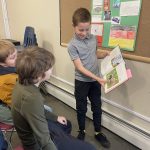Mountain Connection, January 23rd, 2024
By: Jed Donnel
Last week, I had the pleasure of observing Cody’s Advanced Social Philosophy class, which scrutinizes the social world and looks at its identities, relations, and power structures through a philosophical lens. For the unit, “Leavers and Takers: the Game!,” students began by researching a selected region of the neolithic and bronze ages and “the geographic factors that give rise to its most powerful societies in the early days of large-scale social organization.” In the process, they needed to investigate the logic of Jared Diamond’s hypothesis about ‘geographic luck’ as the main determining factor of a nation’s prosperity, power, and technological advancement, and eventually design a game – actually coherent and playable by two to four people – that demonstrated the nuts and bolts of their findings. The period I observed likewise provided an excellent example of the useful and complex methods of project-based learning. Cody’s students were in the later design phases of the games they had devised within small groups, and their respective games were intended to replicate the modes by which each civilization came into being while providing enough variation within the rules to result in different, plausible outcomes. In essence, and as Cody reminded them during the opening discussion, civilizations “are predicated on having a surplus of resources.” Such surplus – grains, wood, metals, etc. – affords opportunities for more complex methods of action, whether inside and outside of a civilization, such as specialization, the development of capital, trade, and so forth. The three civilizations the students used for their respective games were the Shang Dynasty, Shamanism, and Ancient Egypt. Each group arrived to class with their prototype in place, and I was able to observe what effectively was a form of beta testing whereby I could play along within the rules as written, see what transpired, and help as the students found and accounted for loopholes or missing parts within their designs. Cody laid out the clear objective for the class period, too, which was for the students to revise the rules for their games and simultaneously narrow them to a succinct, clear order in preparation for a formal audience on Monday. As he emphasized, by that point they would need to have moved from prototype to finished product and would have used feedback to hone their original ideas.
I was involved with the Egypt group, wherein the materials for the game were mostly reconstituted from a version of Jenga, along with an assortment of other wooden blocks of mismatched shapes and sizes. Each contestant began with three levels of what used to be Jenga pieces arranged in a compact and stable near cube, and, in the middle of us stood a higher tower (also of Jenga-based beams) which was a bit less stable in a slightly more accidental arrangement and consisted of both tan and various-colored blocks. In premise, each participant was a small and fledgling nation, and we took turns building strength by extracting resources from the center tower and adding each new block to our own tower, thus building it up while the central tower became increasingly flimsy. Likewise, each of the resource blocks had an assigned point value, which helped the winner of the first round to be determined via the eventual height of their tower combined with their total points. Moreover, the colored blocks within the central tower indicated specific resources, whereas the tan blocks were each ‘wild’; selecting a colored block meant you knew the resource and point total, whereas the wild blocks may be a resource and a positive value, or a disaster (famine, for instance) and a negative value. Such information was written underneath the wild blocks and therefore could not be revealed until extracted from the central tower. And, to heighten the negative consequences of bad luck, for each disaster chosen a player needed to also select a misshapen piece and add it to their own tower, making it less stable. Once the central resource tower fell down, round two began and players took turns raiding resources from their opponents’ towers to determine an eventual winner: last tower standing. The design made sense, certainly, and certainly resulted in an interesting game. Likewise, playing it revealed potential design flaws – as invariably happens within beta testing – or at least possible amendments to the rules so as to patch the game’s fabric. For example, if the ultimate objective is to build the highest tower, is there an advantage to simply (perhaps ‘accidentally’) knocking over the other player’s towers after the central resources have fallen? Or, might one team conspire with another, ignore the risk of the central resources altogether, and begin pillaging an opponent’s short tower from the first turn? What if a family were to play the game, and that same family happened to include a relatively temperamental five-year-old who, in their frustration, swatted down the other players’ respective towers? Would such behavior possibly be advantageous? Do the specific resources (copper, stone, wheat, etc.) add up to a specific advantage, somehow (a la Settlers of Catan)? Such questions of course complicate the game, and such complications cause further thinking about both strategies and useful retrainsts, all in line with Cody’s objective for the day. On the whole, it was a delight to see not only the students’ heads working as they regarded complex, abstract material, but also their creativity and flexibility as they worked through the difficulties of turning their abstract ideas into concrete forms. I’ll look forward to hearing how their presentations went. One senior, Brie, assured me this morning, “Jed, my game turned out to be beautiful, and it’s much better than last week. You should see it.”
Now accepting applications for the 24-25 school year!



